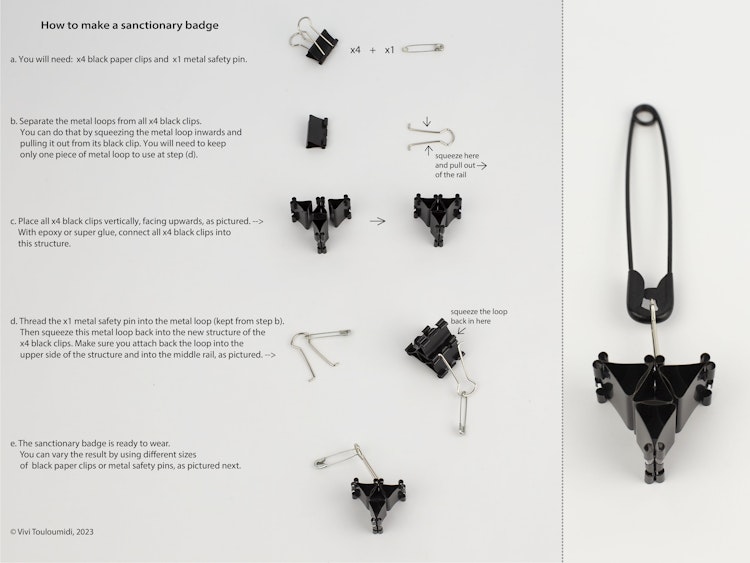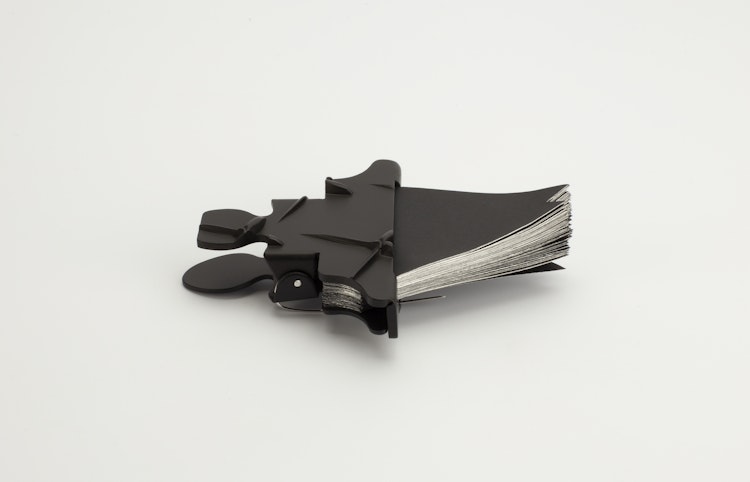

In this essay, Vivi Touloumidi discusses wearable signs and adornment, their ability to carry sociopolitical messages, and the impact they can have on forming subjects and identities. By researching the black triangle, a symbol used during WWII to oppress and categorise so-called “asocials”, Touloumidi found a way to investigate the world-shifting qualities of adornment, and the power of subverting symbols of oppression as badges of honour and protest.
A refusal for categorisation
A principal pursuit of my artistic practice is to investigate wearable and portable art as a medium of agency to carry sociopolitical messages, evoke discourse, and position a body in the public realm. Aspects of suppression as well as resistance are researched through the lens of adornment and jewellery. How these mediums generate affects, but also how they effect social identities, are core questions of my practice. Through this main interest, the symbolic and physical agenda of the body-related object is examined, both historically and in contemporary times, to understand how social friction manifests through materiality. And moreover, to reflect on the world-making agency that adornment has on the body to endorse processes of becoming and of existing otherwise in the world; thus, to engage with the way the world is pushing us, and the way we push back. Could one identify these tendencies through the wearable medium? And how do these intentions materialise and find their way up on to the body and into the world?
Some years ago, I found myself living at close proximity to a well-preserved forced labour camp in Berlin. It was there that I first encountered the wearable badges used during WWII to systematise the bodies of the labourers. Although these badges carried features of conventional decorative items, they were definitely not conceptualised with this mere intention in mind. All normative formats we identify as adornments could be recognised on these badges; small in scale, relational to the body, attached on the torso, public and visible to others, portable, and mobile. Yet the ones on display at the Nazi Forced Labour Documentation Centre Berlin-Schöneweide were not proud possessions to their wearers. These were worn in the absence of free will, and were made to restrict the identity of their wearers. From the perspective of a maker trained in contemporary jewellery, it was therefore inevitable that I should ask this ontological question:1 is this jewellery?
Triggered by this question and my visit to the forced labour camp in Berlin, I began reseaching deeper into this moment in time, where a selected few were eliminating other options of becoming or existing otherwise; and for this endeavour they too were employing the principles of adornment and its impact on forming identities. Specifically, I delved into the design development of the wearable signs employed during WWII, both at forced labour and concentration camps, to stigmatise, systematise, and categorise human bodies, according to the value system of the regime and its propaganda towards unwelcome targets. At Bundesarchiv in Berlin, a substantial and well-preserved archive of bureaucratic letters on the matter proved to be valuable for my inquiry. Investigating the wearable medium in its reverse expression — when devaluing the body, rather than when enhancing it — also proved most meaningful in understanding the medium in depth. We comprehend things of the world better, if we become aware of how much damage they can do to it.
My work eventually focused on the black triangle used to categorise so-called “asocials”. A sign much less investigated by scholars of WWII in comparison to the others, like the red triangle (political) or the pink triangle (homosexual). The latter remains the best known today, as LGBTQ+ movements have appropriated it decades ago, turning it into one of their emblems of protesting their right to otherness. A strategy known as “detournement”, twisting and mirroring an element back to its initial source as a political gesture of dissent. In the ’80s for example, the ACT UP movement.2 reclaimed this badge of shame, subverting it as a badge of honour. However, the black triangle remained a forgotten category; initially interpreted as irrelevant, it has recently started to draw the attention of researchers. In fact, the black triangle has been a much more intersectional category, grouping together everyone from homeless people to prostitutes, disabled bodies, and nonconformist women who refused to willingly fulfil the lifestyles imposed on them by policymakers. Interestingly, a distinction was made between male and female homosexuality; lesbians were categorised as “asocials”, instead of being assigned the “pink” triangle which was used to label homosexual men. Today, the black triangle is considered to be the most “feminised” category of these WWII symbols — and the reasons behind this were what triggered me to conduct this research in the first place.
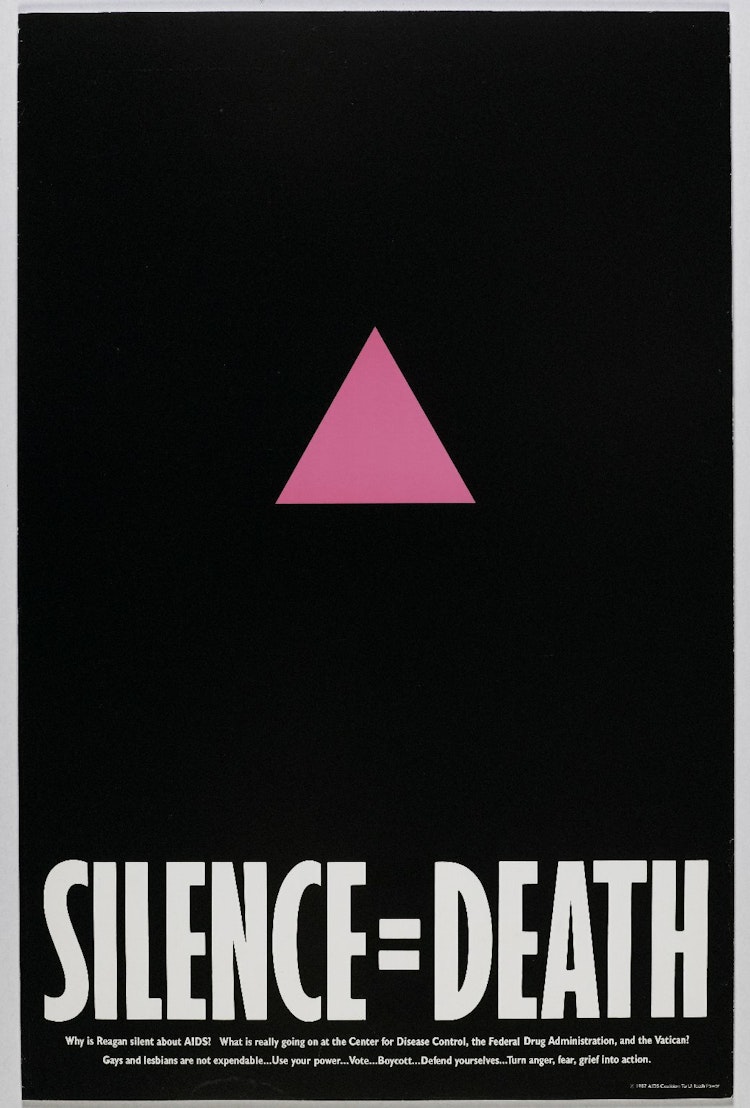
The impulse for this research came not only by looking back in history though, but also by looking around and into the present times. It was hard to overlook and not observe the current dominant political narratives resonating once more in Europe and beyond, especially regarding self-determination, reproductive rights, and social injustice at large, and therefore to not juxtapose past, present, and future. These tendencies produce effects that worry many, including myself. Focusing on the black triangle, and especially on the wilful female targets it was assigned to, made me think of similar public narratives echoing back again today. By wilful targets, I refer to all female subjects who were not willing to fulfil the expected social norms, as defined by the top-down policymakers of that time. Apart from the diverse sub-identities metioned above, this oppression grew beyond sexual orientation, extending to matters of self-determination and motherhood back then as well. Wilfulness is understood here as an error of the will, as intersectional feminist Sara Ahmed describes it: ‘… to be identified as wilful is to become a problem. If to be wilful is to become a problem, then wilfulness can be understood as problem of will.’ One can alternatively understand this as the error of not wanting the things one is supposed to want by society.
While contemplating these ongoing social polarisations, as also the cost of conformity (or the lack thereof), the embodied experience of the research itself at the Bundesarchiv Berlin and the abundance of bureaucratic files started getting at me. Things started to fall into place intuitively. The Büro-desk environment, and my bodily repetitive gestures to manage the files, had influenced the outcome of the research. Stationery tools, paper clips made to categorise documents at the office desk, became tools to think with and reflect upon. While processing all the paperwork and reading all the correspondence letters, the expression “the banality of evil” of philosopher Hannah Arendt was made clear to me. Arendt coined this term to summarise that the people who conducted such acts during WWII were not “evil monsters”, but people of the everyday, following orders with no self-reflection on their own acts. The banality of following proceedings, with no criticality of what was at stake. The correspondence letters I found in Bundesarchiv Berlin demonstrated this term by Arendt impeccably. Officers took pride in their thorough execution of duty when they categorised human bodies accordingly into wearable signs.3 The aim of my work grew, therefore, beyond a detournement gesture of an evil sign, beyond the gesture of inverting the black asocial sign as a protest badge, similar to the case of the pink sign for the LGBTQ+ community. It became a meta-detournement of the bureaucratisation itself, the evil banality of categorising . This deeper understanding led me to compose the wearable badges of the work vom Abzeichen zum Auszeichnen4 that merge the black triangle with stationary classification instruments into a new assemblage and, moreover, to aim to speak of resilience, emancipation, and self-determination of the social body beyond the limitations of labelling and framing identities. Instead of suggesting a subverted alternative, the intention is to embrace a process of constant becoming.5
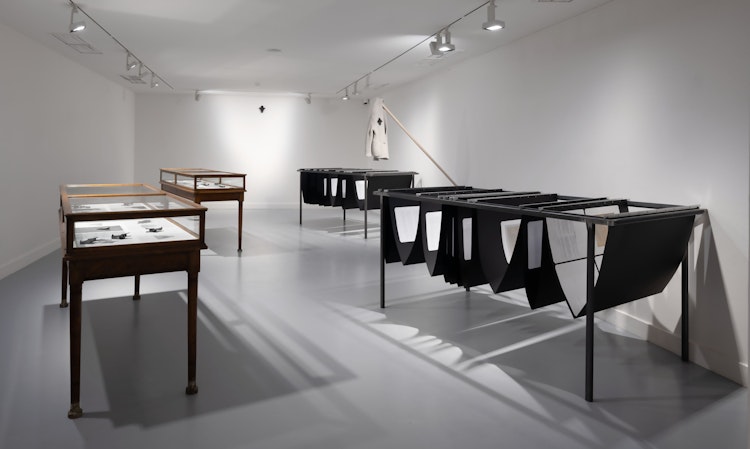
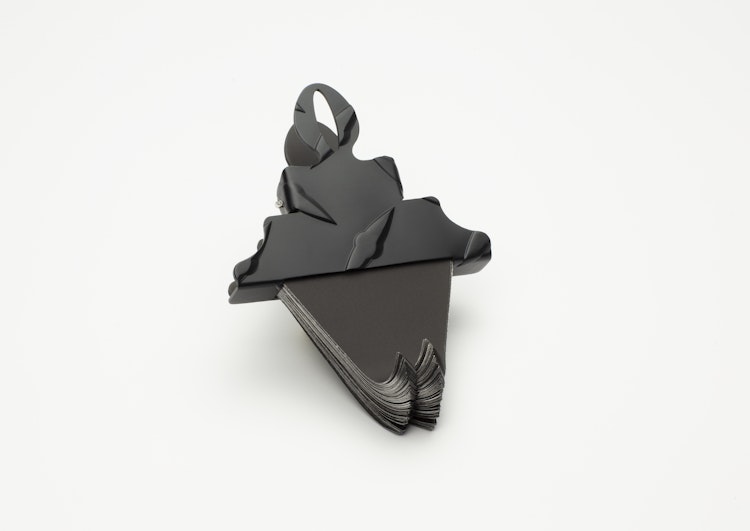
Matters of the will
Social change has higher chances of bursting into existence when we are many. Still, the first step starts with the willingness to confront oneself and the world. This one-to-one terrain of debate is well occupied by jewellery and adornment. ‘Like articulation and identification, expression is an essential step in a stage of emancipation’6, to quote my PhD supervisor Pascal Gielen.
Similarly, in her essay about the suffragette movement in Britain (1908-14), gender theorist Wend Parkins unfolds their strategies, pointing out how this emancipatory demand found its expression and articulation on the body: ‘the cultural intelligibility of the suffragettes’ bodies was open to interpretation; the disparity of meaning between the appearance and the actions of those bodies activated a clash of meaning within an agonistic public sphere …’7 Parkins locates the success of their campaign through the words of gender theorist Judith Butler, who argued that the forms of protest which have the greatest efficacy are those that, while drawing on conventions of previous protest cultures, are not immediately legible; ‘the ones that challenge our practices of reading, that make us uncertain about how to read, or make us think that we have to renegotiate the way in which we read public signs.’8 The variety of suffragette practices of personal display negotiated the women’s status within the body politic of that time.
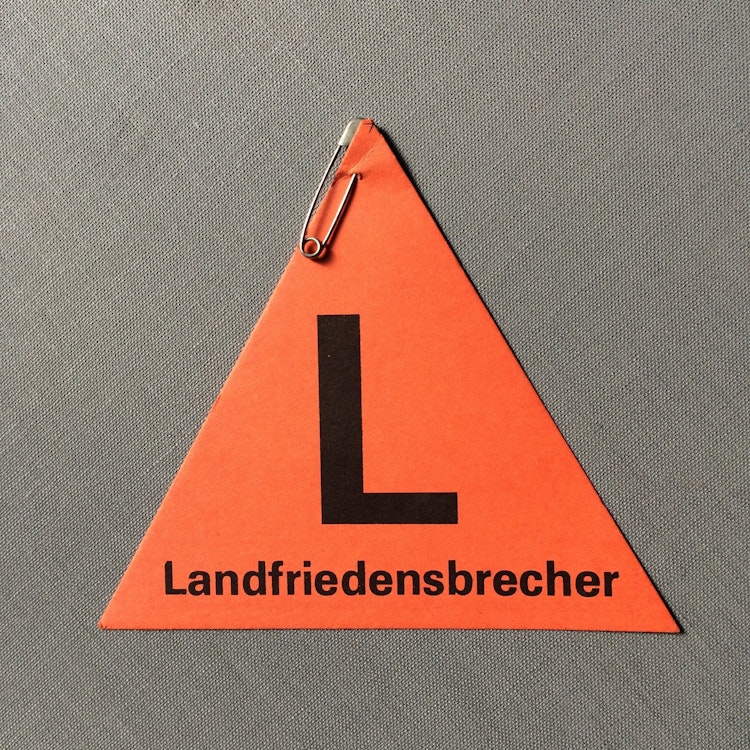
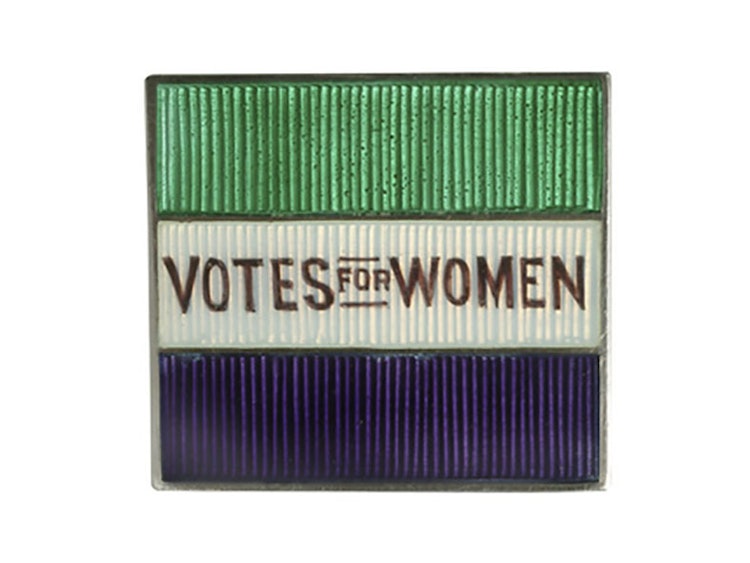
Matters of the will matter. Ahmed tells us about when things start to happen. ‘To make things queer is certainly to disturb the order of things … the effects of such a disturbance are uneven, precisely given that the world is already organised around certain forms of living – certain times, spaces, and directions.’9 The word “queer” here means “being at odds”; it is not specific to any gender or sexuality. Can an object be at odds? How can one create such an object? ‘Whether the strangeness is in the object or in the body that is near the object remains a crucial question.’10
Today, the individual is a moving individual, in the same way that the meaning of objects is mobile and context dependent. Sociologist Laura Brovone informs us that the problem begins when identity is considered as something to be achieved. So, not as a given fact, but as a task. As a postmodern problem, it is primarily about how to avoid fixation and keep the options open.11 This challenging task comes with the ambivalence of being the subject and the object of oneself, while at the same time aims at keeping this ambiguity of multiple interpretations in action.
The will to conduct and conform. The willingness to adapt or the wilfulness to disrupt. A work by jewellery artist Bernhard Schobinger from the ’80s suits the discussion here well. The red triangle, the political one mentioned above, was (similarly to the pink) employed for social debates. It is still used at antifacist demonstrations, subverted accordingly. Schobinger builds on this protest culture when he distributes his own version at a demonstration in Zurich. The imprinted text reads, ‘Landfriedensbrecher’: the one who disturbs the peace of the land. When the world has become ‘… what we learn not to notice, (then) noticing becomes a form of political labour.’12
To become multiple
Being willing to notice and unlearn are existential processes of becoming at a personal scale. These world-facing acts may be singular steps for an individual, yet they add up towards the emancipation of the collective body. Self-determination and resilience precede broader social emancipation. As political theorist Jane Bennett notes: ‘Perhaps, the ethical responsibility of an individual human now resides in one’s response to the assemblages in which one finds oneself participating …’13 As we can only ‘… use our particulars to challenge the universal’,14 one can push further by picking up things from where one finds oneself at.
Though more than a century apart, the suffragettes and the members of the group Pussy Riot have this approach in common: they both started from where they found themselves entangled. They also share strategies; making through having fun is one of them. Being collective and performative are the most obvious ones. But most striking of all, are their shared social struggles against patriarchal oppression, which still persist. Pussy Riot built their cultural identity on punk culture, inspired both by their aesthetics and their idiosyncratic DIY spirit. Here, collective identity and political endeavour found their materialisation through sharing knowledge and skills, mostly via social media, and most famously by crafting balaclavas. In support of the protests of Pussy Riot, women endorsed their revolt, from near and far, through crafting their own masks and joining the public dissent. Masks are meant to embody here a multiplicity of identities. As scholar of interdisciplinary politicised art Ele Carpenter describes, such activist tendencies in craft are a ‘… social process of collective empowerment, action, expression, and negotiation’.15 Online guides on how to make the balaclavas are easy to find. A typical world-making object of feminist activism that rearranges and repurposes materials from pre-existing objects, creating new assemblages of meaning. The anthropologist Alfred Gell identifies social agency as a general attribute of objects, in that an object manifests intentionality. Thus, we remake meaning through thoughtful intervention. Assigning meaning and transforming masks to purpose makes these masks social agents, world-making things. The ambiguity of craft has served as a medium for subversive political activities, such as these and many others. It has also served as a vehicle forchallenging ways of being in the world. ‘If, as I believe, we live out social relations though materiality, then feminist reconfigurations and reinvention of craft objects are also part of the transformation of the structures of knowledge.’16
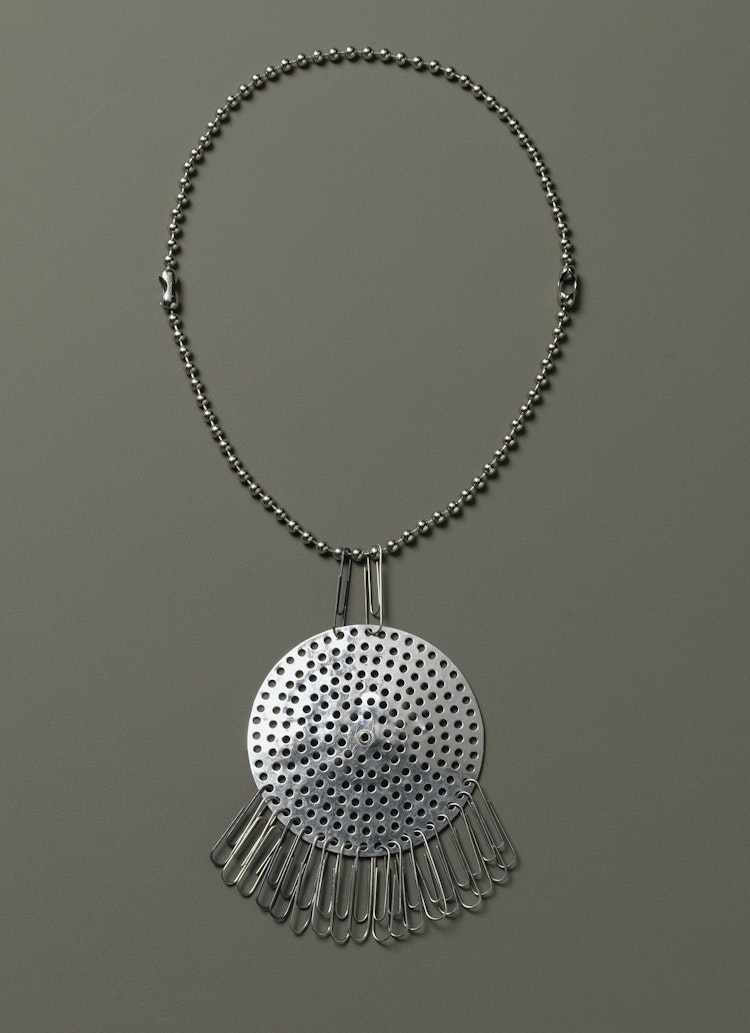
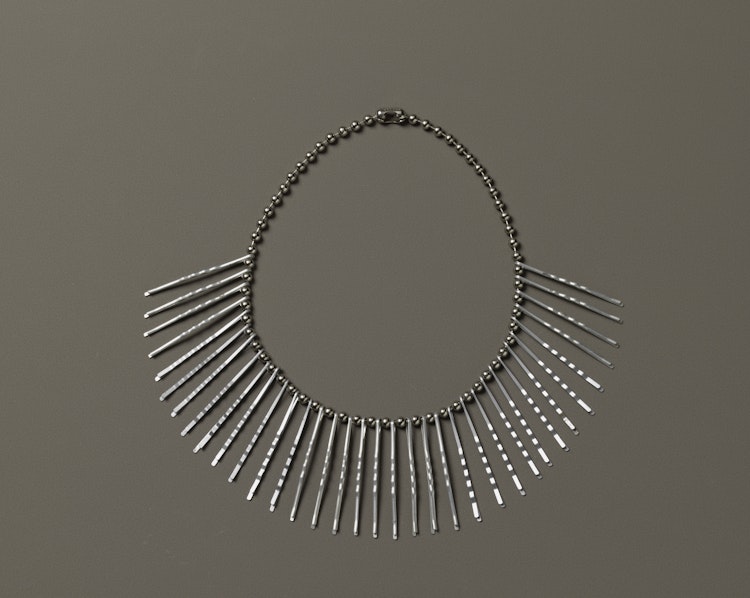
Rehabilitating materials to challenge social constructs goes way back also in jewellery, like in the hardware collection from 1941 by Anni Albers and Alex Reed at Black Mountain College. They wanted to demonstrate that there is no hegemony among objects; paper clips attached to a sink strainer was enough to create a necklace. Even today, one can buy kits to reproduce this collection with no skills needed at all. I am referencing this work here, because its makers were active on the other side of the ocean when WWII was dominating Europe. Though the work was not made as a response to the war, Albers does in retrospect find meaning to the claim when she is asked to refer to it as “defence work” in some way: ‘… every action transmits its sense or nonsense beyond its actual radius, whatever we do has its effect. To give our actions the meaning we want them to have implies questioning them anew and becoming conscious of their implications.'17 Here too, the first stimulus for creating the collection came from working with the world as found.' Every general movement is carried by small parts, by single people forming their way of believing and subordinating everything to this belief. We have to work from where we are. But just as you can go everywhere from any given point, so too the idea of any work, however small, can flow into an idea of true momentum.’18
